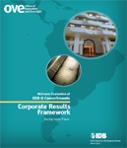IDB-9: Corporate Results Framework
Date
Mar 2013
In IDB-9 the Board of Governors of the Inter-American Development Bank (IDB or Bank) mandated implementation of a corporate results framework (CRF), leading to greater emphasis on results throughout the Bank. This background paper responds to the Governors' request that the Office of Evaluation and Oversight (OVE) evaluate the completeness and effectiveness of CRF implementation at the IDB-9 midpoint. The findings of this paper are based on a review of relevant Board and Bank strategic and operational documents as well as interviews with mid- and senior-level staff and Executive Directors. Given the Board¿s emphasis on the experience of other multilateral development banks (MDBs) and donors in implementing corporate results frameworks, eight representatives from five organizations (four MDBs and one bilateral donor) were also interviewed and relevant documents reviewed. OVE finds that the IDB has made significant progress toward managing for development results anchored in a CRF. However, the CRF has not yet become an integral tool to guide the Bank¿s overall strategy and operations, as IDB-9 envisioned. Inconsistencies and gaps in the CRF structure reduce the value of the CRF for purposes of setting corporate goals and future (post-2015) targets, monitoring corporate progress, evaluating corporate performance, reinforcing corporate accountability, and supporting corporate decision-making. Quality control of data and reporting of CRF information are further weaknesses. The Bank is still in a relatively early stage of implementation, given that many of the targets are only formally effective in 2012 with the first round of subscriptions to the capital increase. This paper thus identifies a number of issues that can usefully be addressed going forward. Based on these findings, OVE suggests that the Bank (i) correct inconsistencies and gaps, to the extent possible, before the 2013 Development Effectiveness Overview (DEO) is issued; (ii) strengthen identification and measurement of outputs and intermediate and sector outcomes to provide a stronger link between operations and higher-level results; (iii) study existing examples of good practice, such as that in the Andean Countries Group, for possible wider applicability within the Bank; (iv) prepare a document describing the process of generating, collecting, entering, and vetting data that go into the CRF and submit to the Board for formal approval to ensure transparency and accountability; (v) de-emphasize descriptive project narratives in the DEO and synthesize project information to illustrate issues that emerge from the CRF tables; (vi) at the end of the current CRF period in 2015, assess implementation experience since 2010 and make warranted revisions in the framework before the period beginning in 2016; and (vii) focus the work of the recently established CRF "Community of Practice" of the MDB Working Group on Managing for Development Results on the complex issues facing all MDBs, such as moving to higher results levels and using CRF information for evaluating staff performance.



